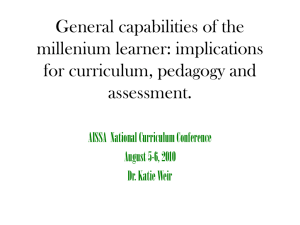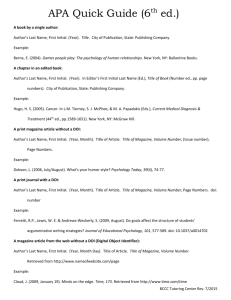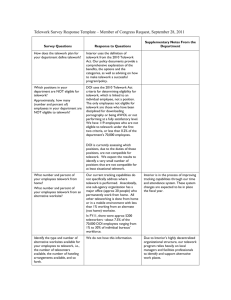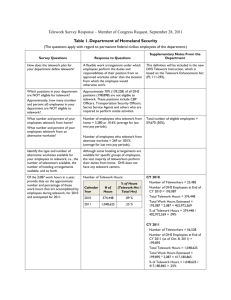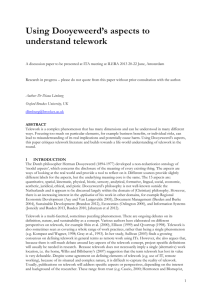Presentation by Dr. Ann Gladys - Diversity in Leadership Conference
advertisement
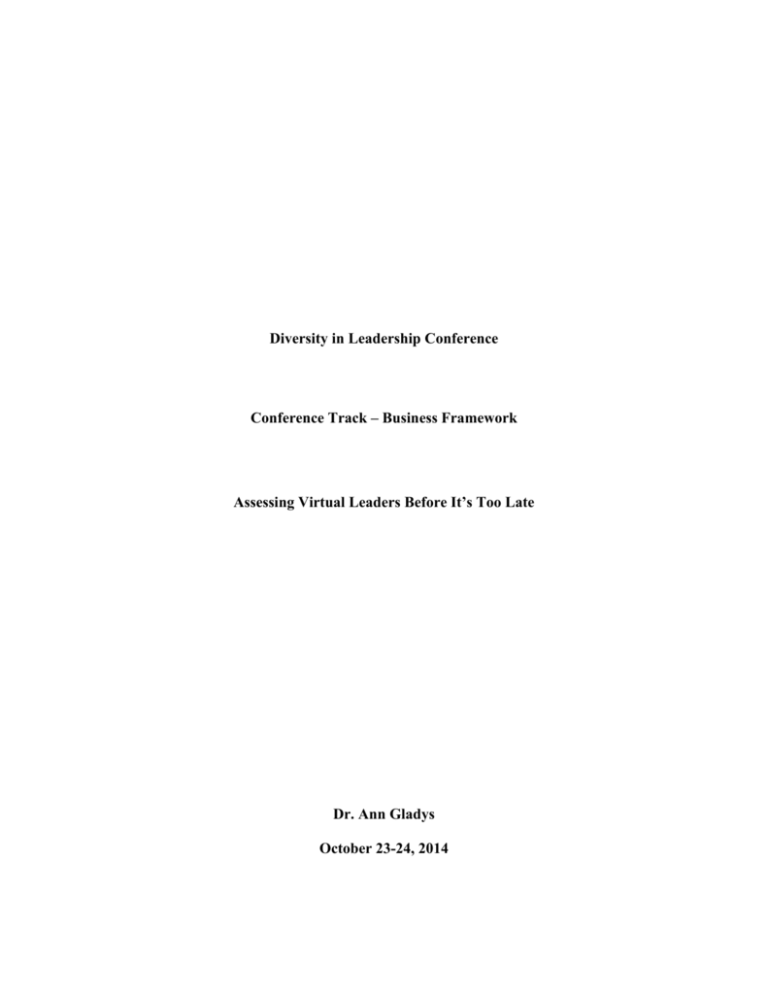
Diversity in Leadership Conference Conference Track – Business Framework Assessing Virtual Leaders Before It’s Too Late Dr. Ann Gladys October 23-24, 2014 2 Assessing Virtual Leaders Before It’s Too Late Abstract The environment of virtual work has continued to spiral upward since its inception some 40 years ago. In fact, within the next few years we can expect that more than one billion people will work virtually. Even more surprising is that within this same timeframe, many employees will never meet their leaders. Yet, in spite of the prevalence of virtual work, questions still remain concerning the viability of allowing employees to be removed from the classic office environment. Questions such as the following abound. Can virtual work simply be described as doing the same work in a different venue? Is the virtual workforce merely a construct of technology? Where does the virtual worker fit into the paradigm of telework? How does leadership of the virtual workforce need to adapt to accomplishing work in a virtual environment? And perhaps most importantly, can I really trust that my employees will actually work when they are away from the office? The fact remains that the culture of virtual work has become increasingly rooted over the years. Most recently, economic struggles and the advanced technology associated with a global economy have set the stage for a more connected workforce in more disconnected venues. Virtual work offers distinct positives for organizations as well as employees. Employers save financially by reducing the costs associated with physical footprints, and employees save commute time as well as commute costs. While virtual organizations may appear to be a panacea for the economic and time complexities that beset employees and corporations, the success of the virtual workforce presents a viable challenge to leaders. Instead of leading less in a relatively anonymous Diversity in Leadership Conference October, 2014 Assessing Virtual Leaders Before It’s Too Late 3 environment, leaders need to alter their leadership behaviors to be able to lead more in the virtual workspace. The significance of this topic rests in the fact that leadership behaviors play a central role in defining the success of a virtual organization (Society for Human Resource Management, 2010). Hence, leadership that is strongly suited to leading virtually is critical. Through an assessment of leadership style, predilections, and capabilities organizations are more likely to achieve success when implementing a virtual construct. Leadership readiness may foretell the likelihood that a virtual organization will thrive, miss performance metrics, or make virtual employees miserable. The purpose of this presentation is to offer insights into the six areas of assessment that drive the indicators of a successful virtual organization in the context of virtual leadership. The presentation also offers each attendee the opportunity to selfevaluate, and determine if they are ready and able to lead virtual employees. Combining leader readiness with the inherently important factors of increasing productivity, retaining employees, reducing absenteeism, maintaining a trained workforce, and promoting quality individuals offers attendees a glimpse into the crystal ball of what it takes on the part of a leader to make a virtual organization to succeed and thrive. Diversity in Leadership Conference October, 2014 4 Assessing Virtual Leaders Before It’s Too Late Introduction Over the past four decades, the global workforce has continued to evolve. Much of this evolution has taken the form of a virtual workspace and in the near future we can expect to see well over one billion individuals employed in nontraditional workspaces, i.e. in non-brick and mortar office structures (Johns, & Gratton, 2013). These workers will work from their homes, from client sites, even from their automobiles. In fact, over time, we can expect that some employees will never meet their managers and leaders. While many of today’s leaders still mistrust the viability of telework, the momentum of virtual work continues to increase. Topping the list of leadership concerns is that of the overall plausible success of the virtual organization. Given the combined force of economic struggles that continue to challenge the financial viability of many corporate and government organizations, coupled with advances in technology that undergird virtual workspaces, the foundation for disconnected work venues is strongly anchored in a redefined way of doing business. More specifically, employers save financially by reducing the costs associated with physical footprints, and employees save commute time as well as commute costs. The significance of this topic rests in the fact that leadership behaviors play a central role in defining the success of a virtual organization (Society for Human Resource Management, 2010). Hence, leadership that is strongly suited to leading virtually is critical. Success for the virtual organization is grounded in metrics associated with five elements; productivity, employee retention, employee attendance, employee development, and employee promotions. Through an assessment of leadership style, predilections, and Diversity in Leadership Conference October, 2014 Assessing Virtual Leaders Before It’s Too Late 5 capabilities organizations are more likely to achieve success when implementing a virtual construct. Leadership readiness may foretell the likelihood that a virtual organization will thrive, miss performance metrics, or make virtual employees miserable. This paper offers insights into the six areas of assessment that drive the indicators of a successful virtual organization in the context of virtual leadership. These assessment vectors reside in the SPELIT Model and consist of social, political, economic, legal, intercultural, and technology indicators. The presentation associated with this paper offers each seminar attendee the opportunity to self evaluate, and determine if they are ready and able to lead virtual employees (Appendix A). Combining leader readiness with the inherently important factors of increasing productivity, retaining employees, reducing absenteeism, maintaining a trained workforce, and promoting quality individuals offers attendees a glimpse into their individual propensity to make a virtual organization to succeed and thrive. Historical Background of Virtual Work Virtual work began in 1972 through the efforts of Jack Niles a University of Callifornia researcher combined the concepts of transportation and telecommunication (Joice, 1998). The nascent period of telework focused on the operational elements of launching a virtual workspace such as timekeeping and the acquisition of equipment (Joice, 2000). With time, it became apparent that there was more to virtual work than policies and procedures. Solomon (2000) asserts, "While employers may provide equipment and technology to telecommuters, that doesn't mean there will be a good cultural fit" (p. 60). Solomon (2000) went on to emphasize that core to establishing a solid virtual work environment was the need to focus on the morale of the teleworker as Diversity in Leadership Conference October, 2014 6 Assessing Virtual Leaders Before It’s Too Late an individual rather than a producer. However, it was the recessionary impact of 2008 that brought the most profound impact on virtual work in the form of economics, a reaction to and need for continuity of operations during natural disasters and acts of terrorism, and a new emphasis on the well-being of the employee (Hunton & Norman, 2010). These changes coupled with extraordinary advances in technology created a tsunami force in the change effects of virtual work. Gibson, Blackwell, Dominicis & Denerath, 2002). Gibson et al. (2002) posit "Technological revolutions lead to people revolutions" (p. 80); and such was the case in the revolutionary changes in virtual organizations. Hence, the onslaught of virtual work changed the face of the competitive marketplace and created a globalized strategy for advancing business. The Successful Virtual Organization Defined Significant research points to five distinct elements that characterize a successful virtual organization. These elements include; productivity (Chronos Consulting, 2011; Maruyama & Tietze, 2012; Rafter, 2011; Robertson & Vink, 2012; Snyder, 2012; Solomon, 2000; Venkatesh & Speier, 2000; Walker, 2010; Yu 2008), employee retention (Chronos Consulting, 2011; Cole, 2012; Gajendran & Harrison, 2002; Gibson et al., 2002; Mulki, Nardhi, Laddek, & Nanavaty-Dahl, 2009); U.S. Office of Personnel Management, 2011; Rafter, 2011; Snyder, 2012; Solomon, 2000; Tutti, 2012; Venkatesh & Speier, 2000), , employee attendance (Gibson et al.,2002; Mulki et al., 2009; Rafter, 2011; Rein, 2012; Robertson & Vink, 2012; Sharit et al., 2009; Synder, 2012; Solomon, 2000; Venkatesh & Speier, 2000; Walker, 2010), employee training and development (Breu, Strathern, & Bridger, 2001; Cascio & Shurygailo, 2003; Diversity in Leadership Conference October, 2014 Assessing Virtual Leaders Before It’s Too Late 7 Chronos Consulting, 2011; Cole, 2012; Cooper & Kurland, 2002; Golden & Fromen, 2011; Joch, 2012; Kayworth & Leidner, 2000; Maruyama & Tietze, 2012; Malhotra, Majchrzak & Rosen, 2007; McCready et al., 2001; Mulki et al., 2009; Rein, 2012; Venkatesh & Speier, 2000; Walker, 2010; Yu, 2008; Zaccaro & Bader, 2003), and employee promotions (Cooper & Kurland, 2002; Elsbach & Cable, 2012; Kanter, 2001; Leonard, 2011; Mulki et al., 2009; Solomon, 2000). Using a framework derivative from transformational leadership (Bass, 1990), the leadership elements of concern for the human element, inspiration/motivation, trust, communication, and training crosswalk with the success elements of a successful virtual organization to provide an architectural construct for defining leadership in the virtual setting. Table 1 below offers the transformational leadership framework derivative, while Table 2 illustrates the crosswalk between the leadership characteristics and elements of a successful virtual organization. Table 1 Transformational Leadership Areas (Gladys, 2014) Transformational Leadership Areas (Bass & Avolio, 1993) Individualized Consideration Intellectual Stimulation Inspirational Motivation Idealized Influence Diversity in Leadership Conference Traits (Bass & Riggio, 2006; Jogulu & Wood, 2007) Mentoring, listening, confidence building, respect, coaching, sociability, feeling, encouragement, autonomy Communication, problem solving solicited, innovative thinking encouraged, training, ideas are not criticized Role modeling, encouragement, inspiration, provides meaning and challenge, creates team spirit, instills commitment Vision, emotional sensitivity, charisma, role model, emulated, interactional, consistent, highly ethical Results (Purvanova & Bono, 2009) Creates pride on the part of employees concerning their abilities and uniqueness Promulgates analytical and logical thinking, and innovation Creates enthusiasm and confidence Inspires devotion and loyalty October, 2014 8 Assessing Virtual Leaders Before It’s Too Late Transformational leadership has become the fulcrum for driving successful virtual organizations in the faceless world of telecommuting. Combining this leadership style with the organizational success factors of a virtual organization offers a glimpse into the research that underpins this construct. Table 3 Leadership Characteristics and Elements of Successful Virtual Organizations (Gladys, 2014) Elements of the Successful Virtual Organization Leadership Characteristics Concern for the Human Element Inspiration and Motivation Trust Productivity Virtual employees are more productive when acknowledged, empowered, and treated as individuals (Nauman, Khan, & Ehsan, 2009). Inspirational leadership is correlated with virtual employees’ focus on achieving organizational goals (Joshi et al., 2009). Retention Virtual employees are more likely to remain with an organization when leadership respects and cares about their well-being (Fisher and Fisher, (2001). Attendance Considering the virtual worker as an individual positively influences attendance (Solomon, 2000). Development Development of virtual employees rests with leadership providing assignments that offer professional growth (Fisher & Fisher, 2001). Leadership that is inspirational and motivational tends to result in commitment and loyalty from the employee (Bass, 1999, p. 11). It is important to motivate virtual employees by assisting them to rise to their potential performance (Clemons & Kroth, 2011). Leaders’ trust is positively related to virtual team performance (Joshi et al., 2009). It is incumbent upon leadership to foster relationships of trust to retain the virtual workers in the knowledge community (Morello & Burton, 2006). Emphasis on well-being in a virtual team influences the commitment demonstrated in areas such as attendance via technical connectivity (Hunton & Norman, 2010). The trust associated with teleworking results in a flexibility that leads to less absenteeism (Gibson et al., 2002). Promotions Leadership that cares about virtual employees creates an environment that is receptive to upward mobility in the organization (Clemons & Kroth, 2011). Inspiration and motivation of transformational leadership in virtual teams lays the ground work for upward mobility (Kanter, 2001). A virtual leader must lead and build relationships of trust where everyone develops through shared ideas and expertise (Malhotra et An attitude of trust on the part of the virtual leader needs to be aligned to ensure the empowerment and potential of virtual employees (Peters, den Diversity in Leadership Conference October, 2014 Assessing Virtual Leaders Before It’s Too Late al., 2007). Communication Virtual employees require extensive feedback and information to enhance productivity (Fisher and Fisher, (2001). Training A productive virtual organization requires a gap analysis of virtual employees is conducted for both IT and non-IT (Yu, 2008). Communication feedback encourages virtual employees to feel a part of the organization and reinforces a connection to the organization (Leonard, 2011). Leaders who ensure appropriate training to virtual employees experience long term retention of employees (Otfinoski, 2010). Virtual teams led with appropriate communication and fewer interruptions see productivity increases correlated with decreased in absenteeism (Gibson et al., 2002). Developing virtual employees via collaborative training is core to their engagement; this level of engagement influences attendance (Busch, Nash, & Bell, 2011). Informal communication with employees aids in development and overall expertise, (Cooper & Kurland, 2002). Leadership must ensure virtual workers have opportunity to grow and thrive through virtual training and online communities of practice (Nafukho, Graham & Muyia 2010). 9 Dulk & De Ruijter, 2010). Communication and inclusion in succession planning is critical so that employees see recognition for their work in the context of career advancement (Leonard, 2011). Professional development and advancement of virtual employees is integral to change management and implementation of virtual organizations. (Yu, 2008). With this construct as a backdrop, the following sections speak specifically to the primary areas of virtual leadership that contribute to the five elements of a successful virtual organization. The Six Primary Leadership Vectors for Virtual Leadership The “as is” state of a potential virtual organization from the vantage point of driving forces can be viewed in terms of social, political, legal, intercultural, and technical realms via the SPELIT Model (Schmieder-Ramirez & Mallette, 2007). This analysis is critical to understanding the current climate of the corporation as well as gaining insight into the forces that may jeopardize the transition into a virtual organization. By segmenting the overview of corporate drivers into separate Diversity in Leadership Conference October, 2014 10 Assessing Virtual Leaders Before It’s Too Late environments, SPELIT offers insight into issues that may be overlooked through other analyses. Table 4 addresses these environments and the individual driving forces associated with each environment. The following sections address each of these environments independently. The Social Imperative for the Virtual Leader The social environment of SPELIT includes reflection on the “social networks, reporting structures, and social cultural norms in an organization” (Schmieder-Ramirez & Mallette, 2007, p. 6). In the virtual setting, the leader needs to reach out to virtual employees demonstrating a sense of concern for each individual. Leveraging social connectivity one-to-one, one-to-many, and many-to-many are integral to creating a cohort of virtual connected team players. Leadership for effective virtual teams is different from face-to-face organizations (Nauman et al., 2009). In fact, the virtual leader must be more flexible and permit others in the virtual organization to lead as situations warrant (Nauman et al., 2009). Nauman et al. (2009), emphasize that leadership style in virtual organizations needs to focus on relationship management, concern for each worker, and offer a level of empowerment suited to the employee. In their research, Nauman et al. (2009) found that these leadership characteristics must be practiced to a far greater extent in a virtual environment than in traditional office settings. Power and Politics as an Indispensable Requirement for the Virtual Leader Diversity in Leadership Conference October, 2014 Assessing Virtual Leaders Before It’s Too Late 11 R. M. Kanter (1980) defines power as, “the ability to mobilize resources (human and material) to get things done”. Kanter goes on to underscore that it is in positioning that a leader gains the means to accomplish an agenda by stating, “Sources of productive power are not with the persona - but at the position the person occupies in the organization” (Kanter 1980). Real power therefore begins with position. Using position to create and enhance power requires leveraging certain keys as Kanter asserts, “The keys to effective power are access to resources, information and support” (1980, p.68). The more effective a leader is in using the keys, the more likely s(he) is to be productive and powerful for “The true sign of power is accomplishment” (Kanter, 1980, p.87) . Having power within an organization allows a leader to influence and execute change. It positions him/her to negotiate and acquire additional resources. And perhaps, most importantly, it postures a leader for additional growth and promotion potential for the leader as well as employees. In terms of political positioning, a position of power gives a leader the ability to influence policy agendas; it provides quick access to C-Level individuals; and it ensures the leader is informed of decisions and shifts in the political environment (Kanter, 1980). However, power does not reside in a vacuum. So how do leaders leverage their resources to gain more power and further enhance their position? They use management practices that will maximize their political position and they leverage their greatest asset; their people. Kanter tells us, “More powerful leaders, delegate more, reward talent more, place subordinates in significant positions [thereby] building a more powerful base thru loyal staff”. He also contends that when, “ employees perceive their manager as influential (powerful) [both] upward and outward, their status is enhanced by association Diversity in Leadership Conference October, 2014 12 Assessing Virtual Leaders Before It’s Too Late and they generally have high morale” (Kanter 1980). High morale and motivation derived from it supplement productivity and help the leader reach performance metrics. From these insights it would follow that if leaders manage their resources well so that their people support them, and concurrently maintain an influential image, they can maximize their potential, effectiveness, and productivity. In the expansiveness of the corporate world, power is not sufficient to ensure continued success. There is an element of influence that can affect and far exceed a power base. In the military world we call them insurgents; those who can wreak havoc on a strong military force. In business, we call them influencers. Influencers are those who can soften or even eliminate the powerful through overt or covert political actions. In the context of the virtual workspace, a virtual leader must blend power and politics in order to be effective. Political activity within an organization tends to increase or decrease in intensity depending on the availability of resources (Chen and Fang 2008). Given this theory, it seems logical in times of economic challenge it is more likely to see political positioning with an eye to accruing any additional limited resources from other organizations. It also supports increased political activities associated with maintaining resources at times of organizational flattening, downsizing, and reorganizations. During these times the impact to staff tends to be reduced job satisfaction, increased job stress, and intentions to resign (Cropanzano et al. 1997; Ferris et al. 1996; Kacmar et al. 1999). In the world of virtual leadership, power and politics are critical for the virtual leader to be able to obtain the necessary resources for virtual employees in order to provide them with developmental training and promotion potential. Diversity in Leadership Conference October, 2014 Assessing Virtual Leaders Before It’s Too Late 13 The Need for Economic Prowess in Virtual Leaders As noted above, the global economic environment is at a critical stage. Worldwide, corporations are taking action to maintain an economic footing by protecting their brands and fostering empowerment that leads to innovation (Friedman, 2005). The India based Tata Corporation maintains a presence around the globe with 350,000 employees, yet anchors its mission on trust, responsibility, integrity, and community (Witzel, 2010). Such is the case for virtual leaders who must leverage economic positioning within the corporation, to ensure there is ample funding for virtual employees to harness a sense of empowerment for the sake of creativity and innovation. Legal Environment The legal environment impacts companies in several ways. The first of these speaks to corporate policy concerning working from home. The second element of the legal environment is concerned with the Federal Occupational Safety and Health Administration (OSHA). While OSHA does not regulate home office spaces, companies are nonetheless required to report accidents whether they occur in the corporate office space or in the home office space (Occupational Safety and Health Administration, 2000). The third legal factor goes to workers’ compensation. In general, workers’ compensation is payable to employees who work from home. However, the rules and guidelines vary from state to state (National Federation of Independent Business, n.d.). It is important that virtual leaders understand the privacy provisions for virtual employees, encourage safety, and stress the importance of ergonomic furnishings for employees while they work from home. The fourth factor is concerned with lease terminations for existing brick and mortar office buildings and the associated lease modification or termination fees. Diversity in Leadership Conference October, 2014 14 Assessing Virtual Leaders Before It’s Too Late Intercultural Environment The international level of acceptance of telework is driven to some extent by the economic wealth of the country. For example, housing conditions in Central American countries may not offer a room or square footage for staging an at-home work environment (Manpower, n.d.). Additionally, obtaining in-home Internet service and acceptable bandwidth may hinder implementation of virtual work in other countries. Hence, prior to launching telework in a given country, it is important for the virtual leader to consider whether working virtually is logistically viable for the workforce in that country. In addition to the logistical factors, consideration should be given to helping home-based workers from different countries work together in virtual teams. Addressing intercultural differences is an imperative for the virtual leader. To assist in this effort, virtual leaders should look to the Intercultural Development Inventory (IDI) to assess how well the workforce is positioned to team across cultures, and identify cross cultural training classes that can foster international collaboration. Technical Environment The leader of a virtual organization has challenges with respect to the technical environment, as its platforms may be dated and not scalable to newer approaches to processing information. Making the leap into the virtual workforce offers the virtual leader the opportunity to upgrade technology in terms of hardware, software, groupware, and video. Transitions to leading edge technologies will serve to improve productivity Diversity in Leadership Conference October, 2014 Assessing Virtual Leaders Before It’s Too Late 15 through enhanced system response time, improved organization of data, and collaborative methods of sharing information and developing innovative solutions for clients. The SPELIT Summary All told, the SPELIT Model serves as a structure and a guide to assessing current and future virtual leaders. Table 4, uses the factors of social, political, economic, legal, intercultural, and technology to identify driving forces that may exist in an organization. Some driving forces take the organization closer to a virtual construct, while others keep the organization locked in an office venue. This matrix below can assist leaders in analyzing the drivers within their organizations that influence a movement towards the virtual workspace. The SPELIT Matrix can reveal an organizational predisposition and need for virtual leadership training. Using the SPELIT Model as a tool for assessing the current environment, positions an organization to consider and act on the factors that will influence the success of its foray into the virtual workspace. While virtual organizations may appear to be a panacea for the economic and time complexities that beset employees and corporations, the success of the virtual workforce presents a viable challenge to leaders. Instead of leading less in a relatively anonymous environment, leaders need to alter their leadership behaviors to be able to lead more in the virtual workspace. Table 4 Using SPELIT to analyze an organization (Schmieder-Ramirez & Mallette, 2007) Environmental Areas Social Driving Force 1 Driving Force 2 Driving Force 3 Driving Force 4 Driving Force 5 Driving Force 6 Social networks Organizational Employees’ Millennials Operational Employees Diversity in Leadership Conference October, 2014 16 Assessing Virtual Leaders Before It’s Too Late layering desire for virtual work venues expect alternative workplace options leaders lack leadership training – including virtual leadership training Lease terminations potential legal issues Political Stockholders and the board are demanding a positive change in finances Government is including sustainability requirements into contracts driving “greener” corporations Operational leaders are prone to control and “empire build” and hoard information Economic Telework can increase productivity as much as 40% Business projections are down so productivity must increase Telework can save thousands per virtual employee annually Legal No current policy and procedures for telework currently exist Worker’s compensation varies from state to state Technology presents security risks vulnerabilities Inter-Cultural Multiple organizations in multiple countries In-home ergonomic and safety risks can create vulnerability The ability to accommodate telework differs by country IDI Assessments and intercultural training are needed Technical Advances in video technology support telecommuting interface Collaborative software enhances peer to peer project work Upgraded systems will support state of the art email systems The company lags in promoting incountry employees to leadership positions Upgraded technology to support teleworking presents costs The Virtual Leadership Assessment The Virtual Leadership Assessment was derived in two steps. The first step is illustrated in Figure 1 and combines the framework of transformational leadership along with research associated with successful virtual organizations. The second step melds the factors of a successful virtual organization with the elements of the SPELIT Model into Table 5. Diversity in Leadership Conference October, 2014 receive little training and have no training to work in a virtual environment Assessing Virtual Leaders Before It’s Too Late 17 Table 5 Crosswalk of SPELIT Factors with Factors of a Successful Virtual Organization Productivity Retention Attendance Development Promotions Social Political Economi Legal Intercultural Technology The Virtual Leadership Assessment tool is contained in Appendix A along with the rubric for evaluating the readiness of current or potential virtual leaders based on their scores on the assessment. Conclusion Diversity in Leadership Conference October, 2014 18 Assessing Virtual Leaders Before It’s Too Late Research indicates that the virtual workspace will continue to grow and that over the next few years there will be some 1.3 billion virtual workers worldwide (Johns, & Gratton, 2013). This level of change presents challenges and a level of disruption for leaders as well as employees. New virtual leaders and employees will become invisible and require will changes in both leadership as well as followership practices. It is imperative that leaders do not succumb to an out of sight/out of mind mentality and leave their virtual employees in the virtual dust. Assessing the current or potential virtual leader and then acting on the assessment by way of training and counseling is critical to ensure the virtual organization is successful. Contained in Appendix A is the Virtual Leadership Assessment (Gladys & Schiemeider, 2014). Overall, the success of a virtual organization largely depends on a virtual leader who is socially intelligent, politically astute, financially positioned to support the virtual employees, aware of the legal ramifications of telework, culturally aware, and technologically savvy. The first step in this process is assessment and, as needed, relevant training to close those gaps identified in the assessment. Solid virtual leadership is not easy to achieve and requires awareness and a desire to lead with a transformational style: a style that acknowledges each virtual worker as an important part of the organization deserving of attention, development, and promotion. Without such an approach, a virtual organization is destined to become one of the majority of virtual organizations considered failures. Diversity in Leadership Conference October, 2014 Assessing Virtual Leaders Before It’s Too Late 19 References Bass, B. M. (1990). From transactional to transformational leadership: Learning to share the vision. Organizational Dynamics, 18(3), 19-31. Bass, B. M., & Avolio, B. J. (1993). Transformational leadership and organizational culture. Public Administration Quarterly, 17(1), 112-121. Bass, B. M. (1999). Two decades of research and development in transformational leadership. European Journal of Work & Organizational Psychology, 8(1), 9-32. doi: 10.1080/135943299398410 Bass, B. M., & Riggio, R. E. (2006). Transformational Leadership. New York, NY: Psychology Press. Breu, K., Hemingway, C. J., Strathern, M., & Bridger, D. (2001). Woekforce agility: The new employee strategy for the knowledge economy. Journal of Information Technology, 2001(17), 21-31. doi:10.1080/02683960110132070 Busch, E., Nash, J., & Bell, B.S. (2011). Remote work: An examination of current trends and emerging issues. Retrieved from http://author.ilr.cornell.edu/cahrs/research /upload/Spring2011_CAHRSRemoteWorkReport.pdf Cascio, W., & Shurygailo, S. (2003). E-leadership and virtual teams. Organizational Dynamics, 31(4), 362-376. Chronos Consulting. (2011). The state of virtual team utilization in the 21st century: A research survey. Retrieved February 10, 2012 from http://www.chronosconsulting.org/dl/Virtual-Teams-Utilization-Research-SurveySep-1-2011.pdf Diversity in Leadership Conference October, 2014 20 Assessing Virtual Leaders Before It’s Too Late Clemons, D., & Kroth M. (2011). Managing the mobile workforce. New York, NY:McGraw-Hill Companies. Cole, A. (2012, May 30). Retaining young feds takes finesse. Federal Computer Week, 15. Cooper, C. D., & Kurland, N. B. (2002). Telecommuting, professional isolation, and employee development in public and private organizations. Journal of Organizational Behavior. 23, 511-532. doi:10.1002/job.145 Elsbach, K. D, & Cable, D. M. (2012). Why showing your face at work matters. MIT Sloan Management Review. 53(4). Retrieved from http://sloanreview.mit.edu/article/why-showing-your-face-at-work-matters/ Fisher, K., & Fisher, M. D. (2001). The distance manager. New York, NY: McGrawHill. Friedman, T. L. (2005). The world is flat. New York, NY: Farrar, Straus and Giroux. Gajendran, R. S., & Harrison, D. A. (2007). The good, the bad, and the unknown about telecommuting: Meta-analysis of psychological mediators and the individual consequences. Journal of Applied Psychology. 92(6), 1524-1541. doi:10.1037/0021-9010.92.6.1524 Gibson, J. W., Blackwell, C. W., Dominicis, P., & Denerath, N. (2002). Telecommuting in the 21st century: Benefits, issues, and a leadership model which will work. Journal of Leadership & Organizational Studies. 8, 75-86. doi: 10.1177/107179190200800407 Diversity in Leadership Conference October, 2014 Assessing Virtual Leaders Before It’s Too Late 21 Golden, T. D., & Froman, A. (2011). Does it matter where your manager works? Comparing managerial work mode (traditional, telework, virtual) across subordinate work experiences and outcomes. Human Relations. 64(11), 14511475. doi:10.1177/0018726711418387 Hunton, J. E., & Norman, C. S. (2010). The impact of alternative telework arrangements on organizational commitment: Insights from a longitudinal field experiment. Journal of Information Systems. 24(1), 67-90. doi:10.2308/jis.2010.24.1.67 Joch, A. (2012, August 24). 5 strategies for taking telework to new heights. Federal Computer Week. Retrieved from http://fcw.com/articles/2012/08/30/feattelework-strategies.aspx Jogulu, U., & Wood, G. (2007). Power struggle. Engineering Management, 17(3), 36-37. Johns, T., & Gratton, L. (2013). The third wave of virtual work. Harvard Business Review. 91(1), 66-73. Joice, W. (1998). History of telework 1972-1998. Retrieved from http://www.teleworknetwork.com/pdfs/63.pdf Joice, W. (2000). The evolution of telework in the federal government. General Services Administration. Retrieved from http://www.gsa.gov/graphics/ogp/ EvolutionteleworkPDF.pdf Joshi, A, Lazarova, M. B., & Liao, H. (2009). Getting everyone on board: The role of inspirational leadership in geographically dispersed teams. Organization Science, 20(1), 240-252. doi:10.1287/Orse.1080.0383 Kanter, R. M. (2001). Power, leadership, and participatory management. Theory Into Practice. 20(4), 219-224. Diversity in Leadership Conference October, 2014 22 Assessing Virtual Leaders Before It’s Too Late Kayworth, T., & Liedner, D. (2000). The global virtual manager: A prescription for success. European Management Journal. 8(2), 183-194. Leonard, B. (2011, June). Managing virtual teams. HR Magazine, 39-42. Malhotra, A., Majchrzak, A., & Rosen, B. (2007, February). Leading virtual teams. Academy of Management Perspectives, 60-70. Manpower, (n.d.). The world of virtual work facts and statistics [Fact sheet]. Retrieved from http://files.shareholder.com/downloads/MAN/164668571x0x117500/ bebbb96d-64a8-4a24-a3ab-1a41eeffb7db/MP_World%20of%20 Virtual%20Work%20Facts_Stats_FINAL.pdf – Maruyama, T., & Tietze, S. (2012). From anxiety to assurance: Concerns and outcomes of telework. Emerald. 41(4), 450-469. doi:10.1108/00483481211229375 McCready, A., Lockhart, C., & Sieyes, J. (2001). Telemanaging. Management Services, 45(12), 14-16. Morello, D., & Burton, B. (2006, March 27). Future worker 2015: Extreme individualization. Gartner, G00138172, 1-19. Mulki, J., Nardhi, F., Laddek, F., & Nanavaty-Dahl, J. (2009). Set up remote workers to thrive. MIT Sloan Management Review. Retrieved from http://sloanreview.mit.edu/article/set-up-remote-workers-to-thrive/ Nafukho, F. M., Graham, C.M., & Muyia, H.M.A. (2010). Harnessing and optimal utilization of human capital in virtual workplace environments. Advances in Developing Human Resources, 12(6), 648-664. doi:10.1177/1523422310394791 Diversity in Leadership Conference October, 2014 Assessing Virtual Leaders Before It’s Too Late 23 National Federation of Independent Business. (n.d.). State by State Comparison of Worker’s Compensation Laws. Retrieved September 17, 2012 from http://www.nfib.com/legal-center/compliance-resource-center/complianceresource-item/cmsid/57181 Nauman, S., Khan, A. M., & Ehsan, N. (2009). Patterns of empowerment and leadership style in project environment. International Journal of Project Management, 28(2009), 638-649. doi:10.1016/j.ijproman.2009.11.013 Occupational Safety and Health Administration. (2000). OSHA instruction CLP 2-.025. Retrieved September 19, 2012 from http://www.osha.gov/pls/oshaweb/owadisp. show_document?p _table=DIRECTIVES&p_id=2254 Otfinoski, D. (2010). How to train and retain your virtual employees? My Business Assistant. Retrieved from http://mybusinessassistantblogs.com/how-to-train-andretain-your-virtual-employees/ Peters, P., den Dulk, L., & De Ruijter, J. (2010). Equality, diversity and inclusion: An international journal. Emerald Article, 29(5) 517-531. doi:10.1108/0261015011052799 Purvanova, R. K., & Bono, J. E. (2009). Transformation leadership in context: Face-toface and virtual teams. The Leadership Quarterly, 20(2009), 343-357. doi:10.1016/j.leaqua.2009.03.004 Rafter, M. (2011, November). Out of site. Benefits Magazine, 51. Rein, L. (2012). Telework guru takes phoning it to new levels at patent office. Washington Post. Retrieved from http://articles.washingtonpost.com/2012-0910/local/35494462_1_telework-patent-trademark-office Diversity in Leadership Conference October, 2014 24 Assessing Virtual Leaders Before It’s Too Late Robertson, M., & Vink, P. (2012). Examining new ways of office work between the Netherlands and the USA. Work, 41, 5086-5090. doi:10.3233/WOR-2012-10425086 Schmieder-Ramirez, J. & Mallette, L.A. (2007). The SPELIT Power Matrix. North Charleston, S.C.: Book Surge. Sharit, J., Czaja, S. J., Hernandez, M. A., & Nair, S. N. (2009). The employability of older workers as teleworkers: An appraisal of issues and an empirical study. Journal of Human Factors in Ergonomics & Manufacturing, 19(5), 457-477. Snyder, K. (2012). Enhancing telework - A guide to virtual leadership. The Public Manager. Retrieved July 22, 2012 from http://www.astd.org/Publications/Magazines/The-PublicManager/Archives/2012/Spring/Enhancing-Telework-a-Guide-to-VirtualLeadership Solomon, C. M. (2000, May). Don't forget your telecommuters. Workforce, 56-61. Society for Human Resource Management. (2010). Successfully transitioning to a virtual organization: Challenges, impact and technology. SHRM Research Quarterly. 110. Retrieved from http://www.global-dynamics.com/uploads/images /2010%201st%20quarter%20SHRM%20%20Research%20Quarterly%20%20Successfully%20Transitioning%20to%20a%20Virtual%20Organization%20%20Challenges,%20Impact%20and%20Technology.pdf Diversity in Leadership Conference October, 2014 Assessing Virtual Leaders Before It’s Too Late 25 Tuuti, C. (2012, January, 23). 2012:The rise of the virtual workforce. Federal Computer Week. Retrieved from http://fcw.com/articles/2012/01/15/feat-watch-listmanagement-workforce.aspx Witzel, M. (2010). Tata: The Evolution of a Corporate Brand. New Delhi, India: Penguin Group. U.S. Office of Personnel Management. (2011). 2011 Federal employee viewpoint survey: Empowering employees, inspiring change. Government Management Report. (pp. 9-25). Washington, DC: U.S. Office of Personnel Management. Venkatesh, V., & Speier, C. (2000). Creating an effective training environment for enhancing telework. International Journal of Human-Computer Studies, 52, 9911005. Doi:10.1006/ijhc.1999.0367 Walker, A. (2010, September, 29). Out of sight, out of mind? Managing the teleworker. Gartner, G00206935, 1-9. Yu, S. (2008, December). How to make teleworking work: Widespread adoption of telecommuting programs is often hindered by non-technical factors. Communication News, 30-32. Zacarro, S. J., & Bader, P. (2003). E-leadership and the challenges of leading e-teams: Minimizing the bad and maximizing the good. Organizational Dynamics, 31(4), 377-387. Diversity in Leadership Conference October, 2014 26 Assessing Virtual Leaders Before It’s Too Late Appendix A Virtual Leadership Assessment General Questions 1) Gender: M F 2) Current Position: __________________________ 3) If applicable, number of years leading virtually: ______ 4) If you are currently a virtual leader, on a scale of 0 to 10, how successful is your virtual organization compared to its brick and mortar counterpart. Indicate a number from 0 through 10, or indicate N/A (a value of 0 indicates your virtual organization compares very poorly with the in-office group; a value of 10 indicates the virtual organization is very successful compared with the in-office group). __________ Please answer the following questions as a current or potential virtual leader. Questions 1-5 Using a rating scale of 0 to 10, please indicate how important you believe the following statements are for leading virtual employees compared to employees with whom you are collocated. Zero indicates far less important; 10 indicates far more important (whole numbers only). Enter your numeric answers in the table that follows the questions. 1) Trusting, empowering, and showing concern on a personal level for virtual employees 2) Recognizing virtual employees through feedback and recognition 3) Providing sufficient time and guidance to complete projects 4) Developing virtual employees through training, leadership, and certification programs 5) Interfacing with virtual employees re long-term plans for promotions Questions 6-15 How well are you positioned within your organization to achieve the following - Zero indicates not well positioned; 10 indicates well positioned (whole numbers only). 6) Fend off last minute assignments and data calls for your virtual employees that originate from higher ups in your organization 7) Communicate the successes of your virtual employees to the hierarchy of your organization Diversity in Leadership Conference October, 2014 Assessing Virtual Leaders Before It’s Too Late 8) 27 Influence the political forces within your organization to provide meaningful projects you can assign to virtual employees 9) Obtain training funds for training your virtual workers 10) Campaign for and obtain promotions for your virtual workers 11) Meet the financial expenses (pay plus benefits) for virtual employees 12) Afford pay raises to retain good virtual employees 13) Obtain the funds to meet short or long term absences of virtual employees 14) Obtain the funds associated with training virtual employees 15) Obtain the funds associated with promoting virtual employees Questions 16-19 How knowledgeable are you concerning the following - Zero indicates not knowledgeable; 10 indicates very knowledgeable (whole numbers only). 16) Ergonomic requirements of the physical setting for virtual employees 17) Creating and/or dealing with a hostile working environment in a virtual organization 18) Effective communication and messaging in a virtual environment 19) HR requirements for development, counseling, and designing/approving training for virtual employees Questions 20-30 How likely are you to do the following - Zero indicates not likely; 10 indicates very likely (whole numbers only). 20) Fairly assign enriching and high-visibility projects to virtual employees 21) Use non-electronic communication to interface with various cultures within your virtual organization 22) Address the intra/inter cultural differences of your virtual employees through respect 23) Welcome and encourage creative input from all virtual employees, inclusive of different points of view 24) Implement training programs for virtual employees to address diversity and cultural differences 25) Coach and mentor your virtual employees across the cultures of the organization 26) Provide state of the art technology to your virtual employees 27) Offer visibility for virtual employees throughout the organization via video technology 28) Provide technology support that is secure, reliable, and up to date to virtual employees 29) Offer technology training to virtual employees 30) Cross-train virtual employees by employing technology Diversity in Leadership Conference October, 2014 28 Assessing Virtual Leaders Before It’s Too Late Enter the values for your answers (e.g. if you answer 7 for question #1, place a 7 in box #1. Then and add the values for the rows and the columns. Also provide a super-total for the answers to all 30 questions by adding either the rows OR the column totals and placing that number in the box on bottom-right. Productivity Retention Attendance Development Promotions Social 1. 2. 3. 4. 5. Political 6. 7. 8. 9. 10. Economic 11. 12. 13. 14. 15. Legal 16. 17. 18. 19. 20. Intercultural 21. 22. 23. 24. 25. Technology 26. 27. 28. 29. 30. Row Totals Column Totals Diversity in Leadership Conference October, 2014

